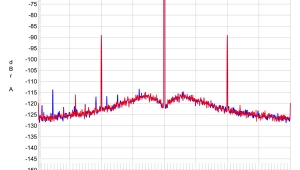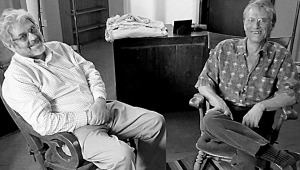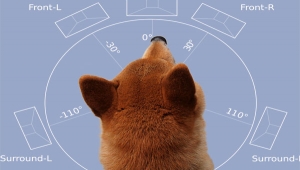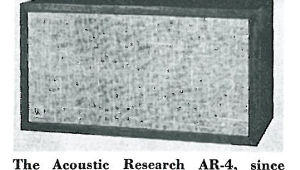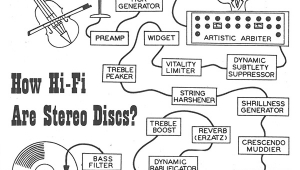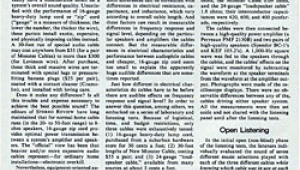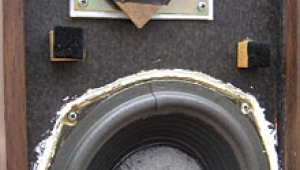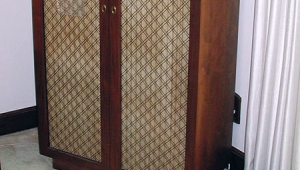| Columns Retired Columns & Blogs |
Bozak Concert Grand B-410 loudspeaker Measurements
Sidebar 5: Measurements
Because of the Bozak B-410 Concert Grand's bulk, it was easiest for me to drive to Peter Breuninger's house in Pennsylvania to measure the speakers in situ. For the measurements, I used a DPA 4006 omni that I had calibrated in an anechoic chamber, with an Earthworks microphone preamplifier and DRA Labs' MLSSA system, dragging the speaker outside into PB's drive-way where I could get it well away from boundaries (other than the ground). However, and also because of the speaker's bulk, I could not raise them off the ground for the measurements, which inevitably reduces the midrange resolution of the measured response.
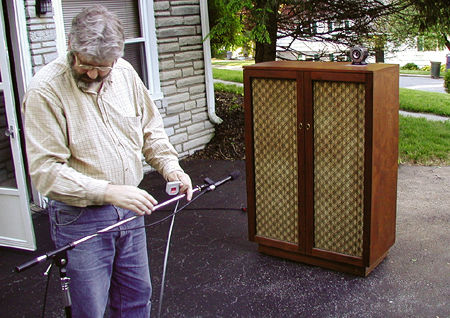
With that caveat in mind, the Bozak was very sensitive, at an estimated 91dB(B)/2.83V/m on the tweeter axis. Its impedance graph (fig.1) revealed the speaker to be a relatively easy load for amplifiers, with a minimum value of 5.5 ohms at 194Hz and an overall mild electrical phase angle in the audioband. The traces in this graph are generally free from the sharp discontinuities that would suggest the presence of cabinet resonances, though there is a suspicious-looking notch just below the single peak in the bass, resulting from the sealed-box alignment. This peak indicates that the four 12" woofers are tuned to 54Hz, which, all things being equal, implies only modest bass extension.
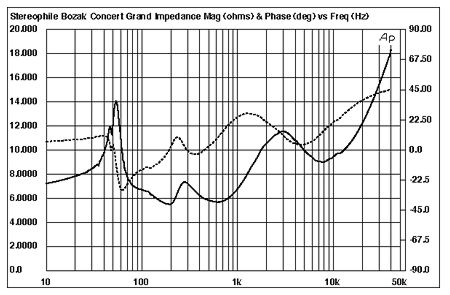
Fig.1 Bozak B-410 Concert Grand, electrical impedance (solid) and phase (dashed). (2 ohms/vertical div.)
A notch also appears in the woofers' nearfield response (fig.2, red trace), just above the gentle, 12dB/octave rolloff associated with the sealed-box woofer loading. The woofers' output peaks between 40Hz and 200Hz, though there is a slight lack of upper-bass energy. The blue trace in fig.2 is the nearfield response of the midrange units; these roll out with a second-order slope below 200Hz, though not without a slight peak at the woofer tuning frequency. The crossover between the woofers and midrange units appears to lie at around 170Hz. However, when the units' outputs are summed and with phase taken into account, the resultant response (fig.2, black trace) lacks energy between 150Hz and 400Hz.
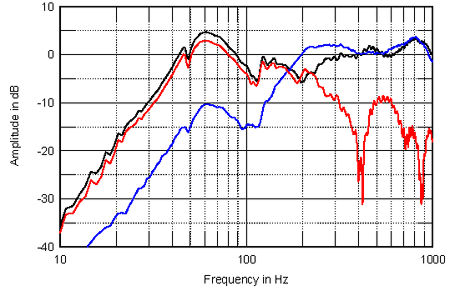
Fig.2 Bozak B-410 Concert Grand, nearfield midrange (blue) and woofer (red) responses, with their complex sum (black).
At first, I wondered if the Concert Grand's crossover topology was sub-optimal, but later I read PB's comment that he had reversed the polarity of the midrange drivers. While this may produce a lower-midrange balance that works better in a particular room—see below my response measurement taken in Peter's room—this is inadvisable in general with designs that use first-order crossover filters. On the other hand, as my time-domain measurements (see later) indicated that after Peter's modification the midrange units and woofers were wired in the same acoustic polarity, perhaps his samples had been miswired at the factory.
All the responses shown in fig.2 were taken in the nearfield; ie, with the microphone capsule almost touching the diaphragms. By contrast, the blue trace in fig.3 above 300Hz shows the response of the Bozak in the farfield, averaged across a 30° horizontal window on the tweeter axis. A series of notches and peaks can be seen in the midrange and low treble. Though these appear severe, they result, I believe, from interference between the multiple woofers and midrange units and will therefore be position-specific. Even taking into consideration the exaggeration of low frequencies due to the nearfield measurement technique, the Concert Grand's low frequencies exhibit a midbass boost that, in conjunction with the relatively slow rollout below the woofer tuning frequency, will give the impression of powerful bass.
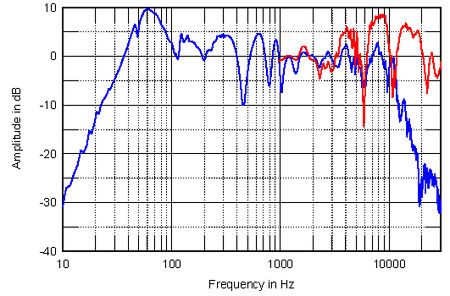
Fig.3 Bozak B-410 Concert Grand, anechoic response on tweeter axis at 50", averaged across 30° horizontal window and corrected for microphone response, with the complex sum of the nearfield midrange and woofer responses (blue). The red trace shows the response on the tweeter axis with a RadioShack supertweeter added in parallel.
The Concert Grand's treble balance is actually quite flat, though it rolls off sharply above 11kHz. Without help, the Bozak tweeter will sound rather lifeless. In his everyday listening PB supplies that help in the form of a horn-loaded RadioShack supertweeter, connecting it in parallel with the Concert Grand and relying on the supertweeter's own high-pass filter. PB faces the supertweeter to the rear, but to give a baseline for this ancillary unit, I faced it forward and repeated the response measurement.
The result is shown as the red trace in fig.3. A series of peaks and dips can be seen between 4kHz and 20kHz, these resulting from interference between the Bozak tweeters and the RadioShack unit, which comes in an octave too low in frequency. In addition, the RadioShack tweeter appears to be about 5dB too sensitive to integrate properly with the Bozak. This is presumably why Peter uses the unit facing away from him, which will allow it to fill in the octave above 10kHz in-room at a reduced level. Even so, in my own auditioning of the Concert Grand with the RS supertweeter, I found the octave between 5kHz and 10kHz a little prominent. I would try rolling in the RadioShack an octave higher in frequency.
Because I measured the Concert Grand on location, I couldn't perform a complete set of off-axis measurements. However, the peaks and dips in the on-axis response do vary according to the mike position, as I conjectured above (fig.4). In-room, their effect may well be relatively innocuous, which is to a large extent confirmed by fig.5. This is the overall spatially averaged, 1/3-octave response taken for each speaker individually. (To measure the Bozak's in-room response, I played pink noise through each speaker in turn and recorded the microphone's output on my laptop with a Metric Halo ULN-2 Firewire interface.) PB's corner placement for the Concert Grands results in a smooth, extended bass register that rolls gently off below the 40Hz band. The curve is impressively flat overall, though the region between 1.25kHz and 10kHz is slightly shelved-down. And, of course, without the supertweeters the speaker's response plummets like a stone above 10kHz.
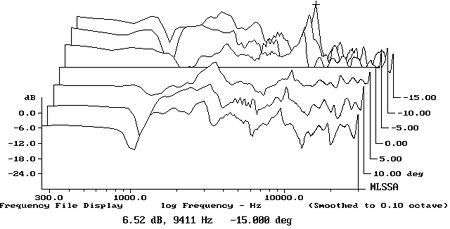
Fig.4 Bozak B-410 Concert Grand, lateral response family at 50", normalized to response on tweeter axis, from back to front: differences in response 15–5° off axis on tweeter side of baffle, reference response, differences in response 5–15° off axis on woofer side of baffle.
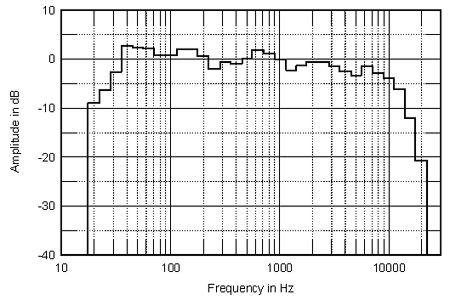
Fig.5 Bozak B-410 Concert Grand, spatially averaged response in PB's listening room without RadioShack supertweeters.
In the time domain, the Concert Grand's step response (fig.6) is complex. You can see, as they arrive successively at the microphone position, the steps of the tweeters, the midrange units, and the woofers, all positive-going. The cumulative spectral-decay plot (fig.7) is disappointing, suffering from a series of resonant ridges in the mid-treble region.
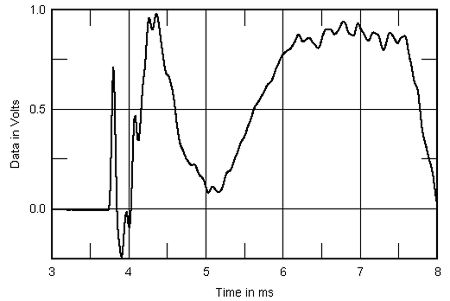
Fig.6 Bozak B-410 Concert Grand, step response on tweeter axis at 50" (5ms time window, 30kHz bandwidth).
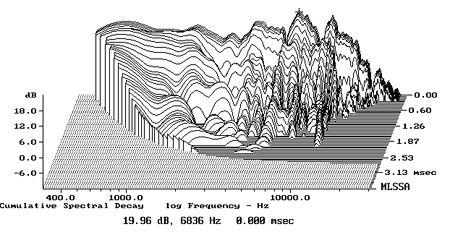
Fig.7 Bozak B-410 Concert Grand, cumulative spectral-decay plot at 50" (0.15ms risetime).
In some respects, the Bozak Concert Grand's measured performance stands up well four decades after its commercial heyday. The bass extension and definition are first-rate, and its in-room balance is impressively flat. Its rather resonant tweeters are definitely a weak point, however, lacking extension and offering an unflat mid-treble. The Bozak's horizontal dispersion is also wayward compared with modern designs. While amplifiers from the Golden Age can still be competitive today, as revealed by PB's review of the Fisher 500-C receiver in June, speaker technology has made enormous progress since the early 1960s.—John Atkinson
- Log in or register to post comments

